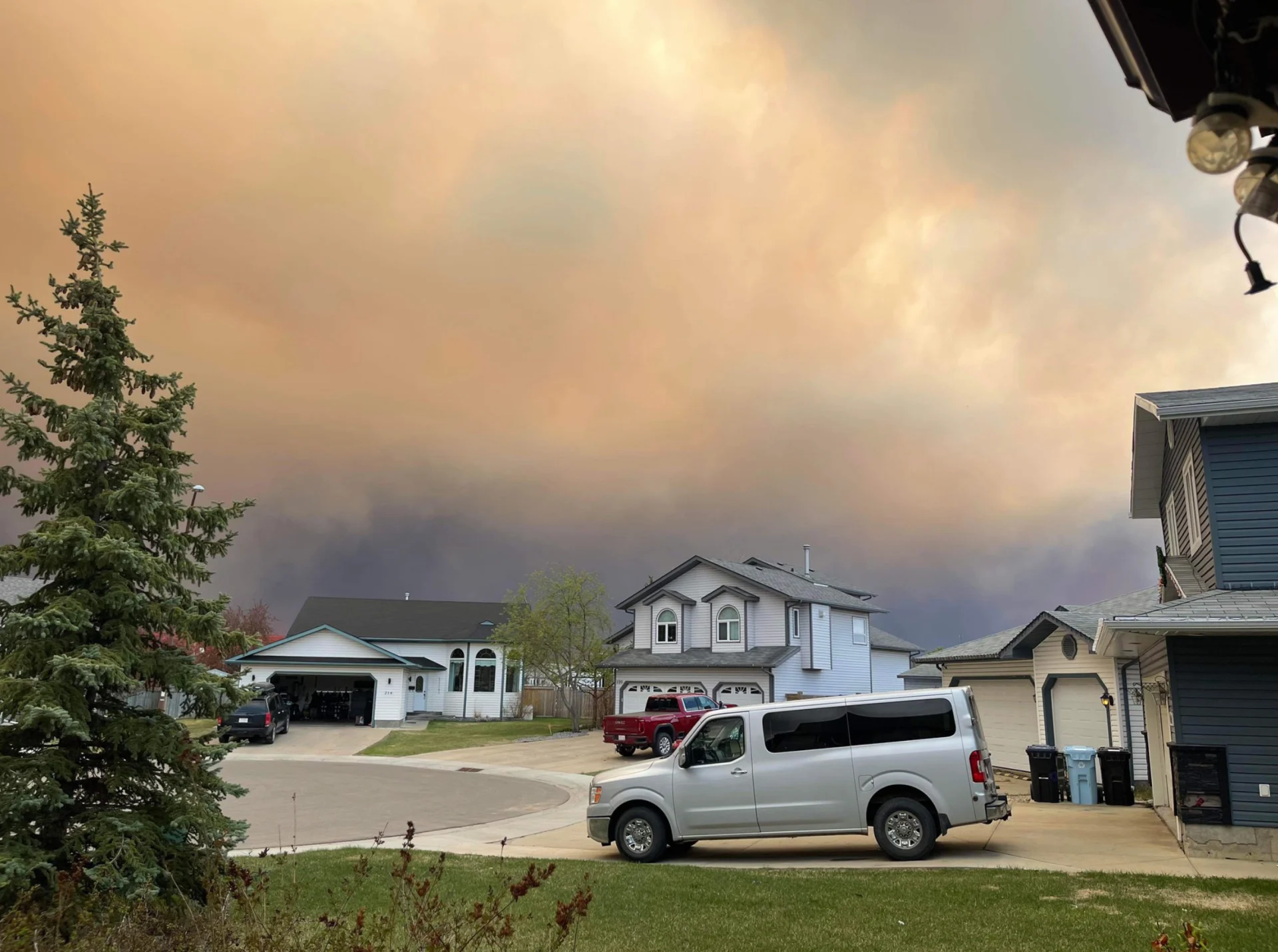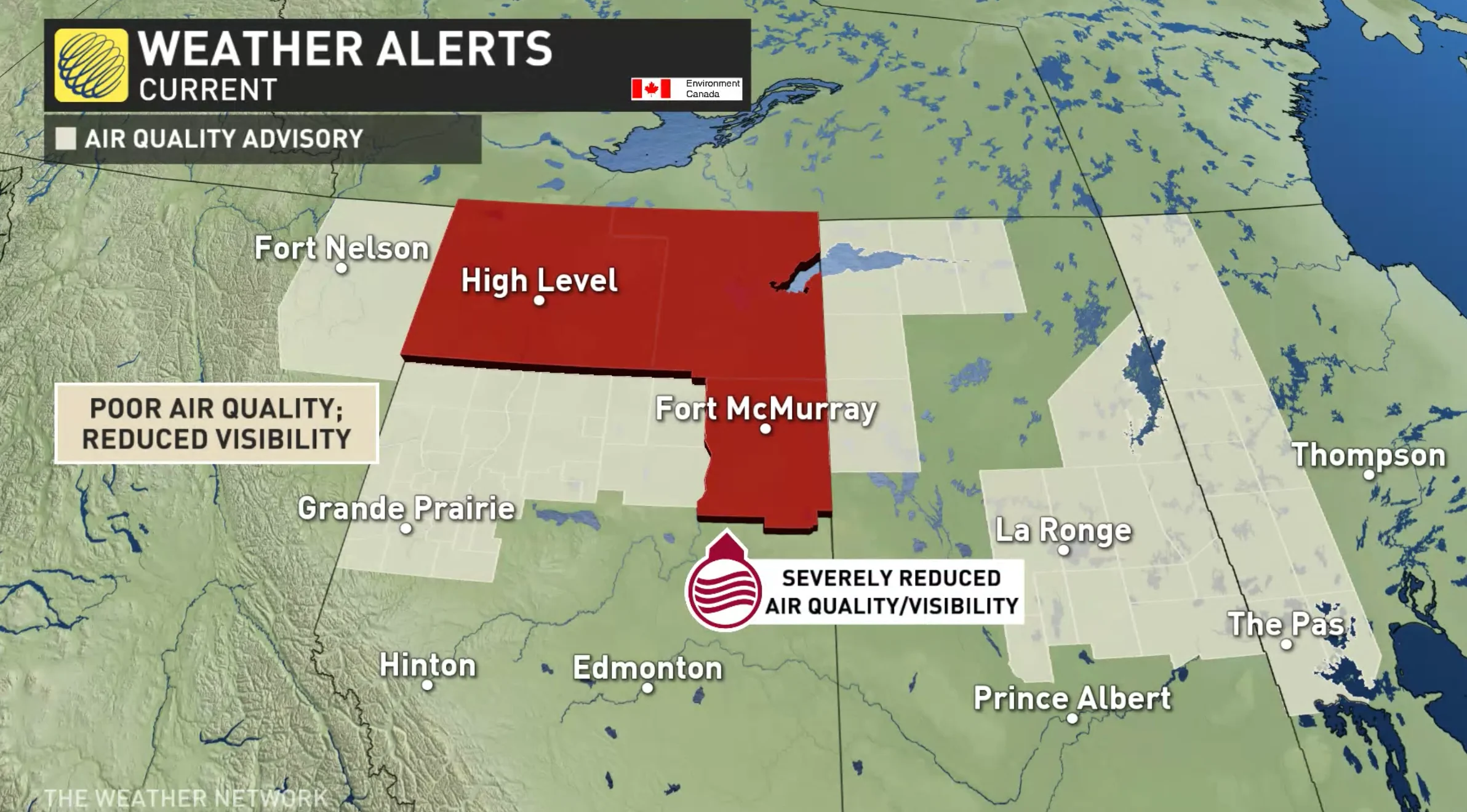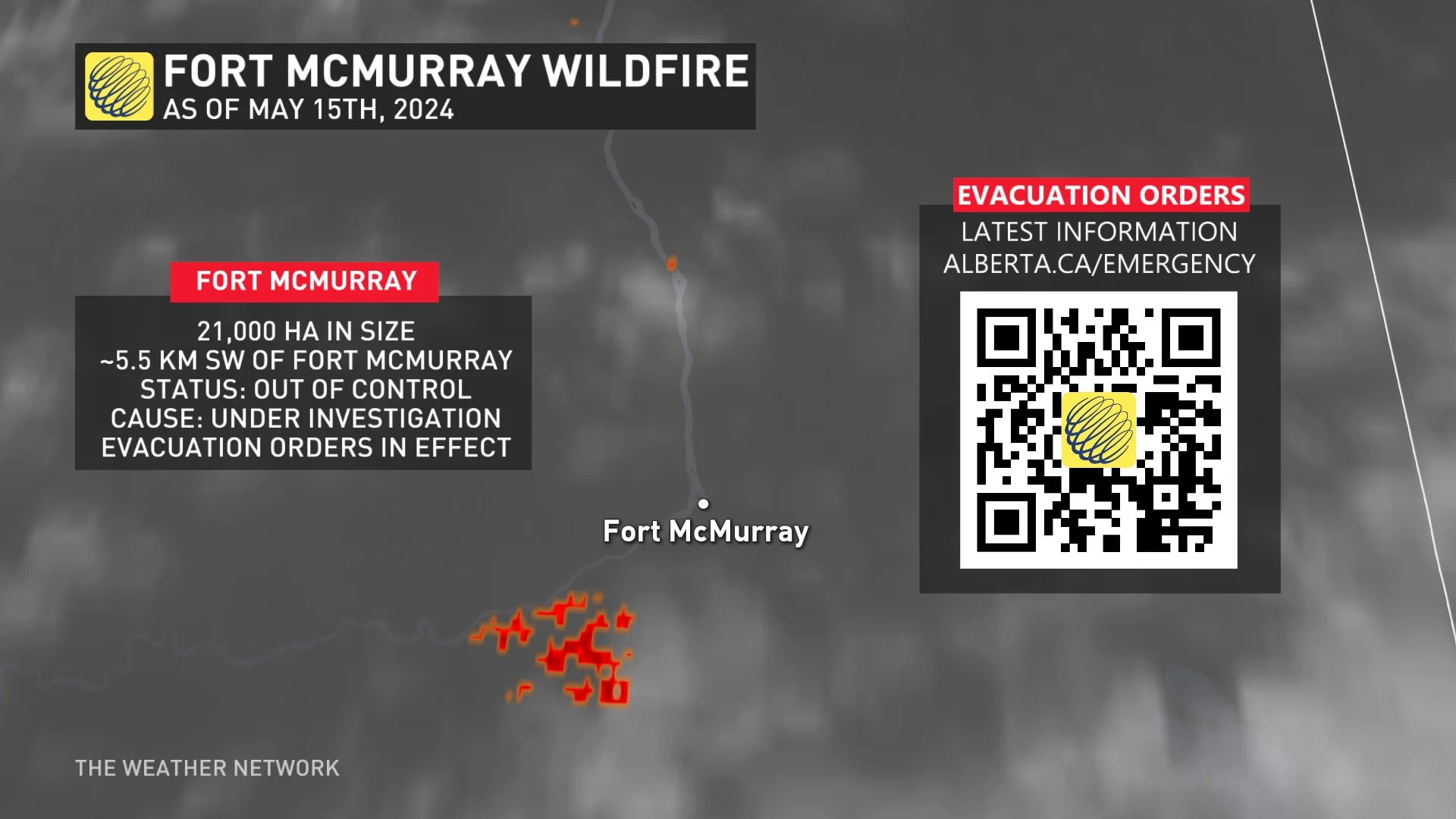
Fort McMurray wildfire remains volatile but weaker winds expected to ease danger
CANADA'S WILDFIRES: Visit The Weather Network's wildfire hub to keep up with the latest on the active start to wildfire season across Canada
A wildfire that forced more than 6,600 people from their homes in Fort McMurray continues to grow, threatening a northeastern Alberta community that was ravaged by fire eight years ago.
Four Fort McMurray neighbourhoods — Beacon Hill, Abasand, Prairie Creek and Grayling Terrace — were evacuated Tuesday as a wildfire grew dangerously close. Evacuees are being told they will likely remain out their homes for at least another week, possibly longer.
As of Wednesday morning, the fire had consumed nearly 21,000 hectares of forest, after almost doubling in size the day before, and moved closer to the community as it spread rapidly toward the northwest.
After days of volatile fire activity, a favourable change in the weather is expected Wednesday with cooler temperatures and weaker winds that are expected to push the fire away from homes and businesses.
During a news conference Wednesday, Alberta Premier Danielle Smith acknowledged that Fort McMurray is no stranger to the devastation wildfires can cause.
"As residents rushed to leave their homes, I know that this will bring back difficult memories from the devastating fires of 2016, and I'm sure these memories will create fear and uncertainty for many in Fort McMurray.

A wildfire threatening the community has now consumed nearly 21,000 hectares as shifting winds and rising temperatures continue to accelerate its growth and push the flames closer to the municipality. (Submitted by Rochelle Yurko)
"My sympathy is with everyone facing this situation but safety must remain our top priority."
The fire is being treated as a top priority by government authorities with 117 firefighters along with 14 helicopters now dispatched to the region.
On Wednesday, the province announced a fire ban and an off-highway-vehicle restriction for the Fort McMurray and High Level regions in an attempt to prevent new fires from sparking.
Hours after the fire ban was announced, officials reported that a new fire had detected about 10 kilometres north of Fort McMurray.
It's burning out of control but covers less than one hectare. Crews continue to battle another 1.8-hectare blaze in Fort Chipewyan, a remote community in the far northern reaches of the regional municipality.
MUST READ: Essential items for your emergency "grab-and-go" kit
The fire threatening Fort McMurray spread rapidly Tuesday, fanned by parched conditions, high temperatures and extreme winds that pushed the flames toward the community's southwestern edge.
Black plumes of smoke funnelled across the sky Tuesday as the wildfire began to consume areas previously burned in 2016, when a wildfire forced the largest evacuation in Alberta history and destroyed thousands of homes and other structures.
It was a familiar scene for many Fort McMurray residents as trucks and cars clogged all roads leading south and firefighters prepared to again defend the city, including many streets destroyed by fire eight years ago.
Outside the evacuation zone, the rest of Fort McMurray, and some surrounding communities in the Regional Municipality of Wood Buffalo, remain on evacuation alert — with residents needing to be ready to leave on short notice.

May 15 air quality update (Source: Environment Canada and Climate Change/The Weather Network)
The wildfire continues to burn out of control. As of Wednesday morning, the closest point of the fire was about 5.5 km from the Fort McMurray landfill on the southern outskirts of the community and 4.5 km from the intersection of highways 63 and 881 — the only highways leading south out of the oilsands hub.
Firefighters have contended with extreme conditions and crews were pulled from the front lines Tuesday due to dangerous conditions, pushing the firefight into the sky.
Helicopters and air tankers continue to fly while crews on the ground build containment lines and set up sprinkler systems to protect homes and businesses under threat.
In an update posted Wednesday morning, Alberta Wildfire said a shift in the winds is expected to push the fire away from Fort McMurray and Highway 63.
Less than one millimetre of rain fell on the wildfire overnight Tuesday. The forecast is for winds to calm.

Updated at 2:40 p.m. (MDT), May 15, 2024. (The Weather Network)
Alberta Wildfire and the municipality have entered into a unified command agreement and are working together to handle the crisis.
Crews have begun to move into the evacuation zone to protect the neighbourhoods most under threat with structure protection such as sprinkler systems.
WATCH: Fort McMurray evacuation order in place until at least Tuesday
Conditions remain extreme
Josee St-Onge, a spokesperson for Alberta Wildfire, said cooler temperatures and weaker winds give firefighters a chance to gain the upper hand. But conditions remain extreme, she said.
The fight continues in the sky with helicopters and air tankers, she said. On the ground, the focus is on building containment lines, creating critical barriers for homes and businesses should the fire not retreat as hoped.
"The change in the weather gives firefighters a good window to make progress but there's still a lot of work to be done to contain this wildfire," St-Onge said Wednesday.

For some Fort McMurray residents like Alex Mortlock, evacuating is a familiar and bitter experience. (Sam Martin/CBC)
"We are still expecting high fire activity today."
The cause of the wildfire remains under investigation.
Evacuees who require food or accommodation are told to report to a reception centre at the Cold Lake Agriplex, 4608 38th Ave. in Cold Lake, Alta.
RV and camping accommodations are available in Lac La Biche, Alta., but hotels are already full from an initial flood of evacuees who arrived Tuesday.
The City of Edmonton has set up an evacuee reception centre at Clareview Community Recreation Centre, 3804 139th Ave. The centre will provide food services, clothing, pet day care and health care. The Red Cross will be at the centre to co-ordinate hotel accommodations.
On Wednesday, Jody Butz, the regional fire chief, thanked firefighters for their work, and residents for ensuring neighbourhoods under threat were evacuated safely.
Butz said many people left the community Tuesday, even in areas that are not under orders to evacuate. He said people living outside the official evacuation zones should feel safe to remain.
RELATED: Evacuation order issued as wildfire threatening Fort McMurray draws closer
"If you left Fort McMurray yesterday, not as a part of the evacuation order, you're welcome to come home, and you're welcome to feel safe being home," he said.
"Other areas remain under an alert, but please know that we're monitoring the situation closely and we have confidence in the safety of these areas."
Butz urged people forced to evacuate Fort McMurray to be patient.
"Many people who have evacuated under an order are already starting to ask questions about when they might be able to return," he said.
"I can only say this in the simplest way: not until it's safe to return to these neighbourhoods. It must be safe."
Different from 2016
Butz has repeatedly reassured residents that the fire threatening Fort McMurray now is less dangerous than the blaze that devastated the community in 2016.
The 2016 fire was relentless, spreading rapidly through the treetops through tinder dry forests. This blaze is moving low ground, through the muskeg and areas previously touched by fire and that is helping to stifle its growth, Butz said.
RELATED: 8 years ago, 88,000 Albertans fled due to the Fort McMurray wildfire
He said the community is better prepared and he remains confident the community will remain untouched.
"I don't plan on losing any power to our residences and I also don't plan on losing any garden sheds," he said."I'm very confident in our resources.
"We're ready to defend our community if needed. But hopefully that won't come to that."
The province will provide financial support for evacuees.
A spokesperson for the Alberta government said Tuesday that just like in previous years, evacuees who are away from home for at least seven days will get $1,250 per adult and $500 per child under 18.
WATCH: MWF-017 wildfire update
This article, written by Wallis Snowdon, was originally published for CBC News on Wednesday, May 15.









